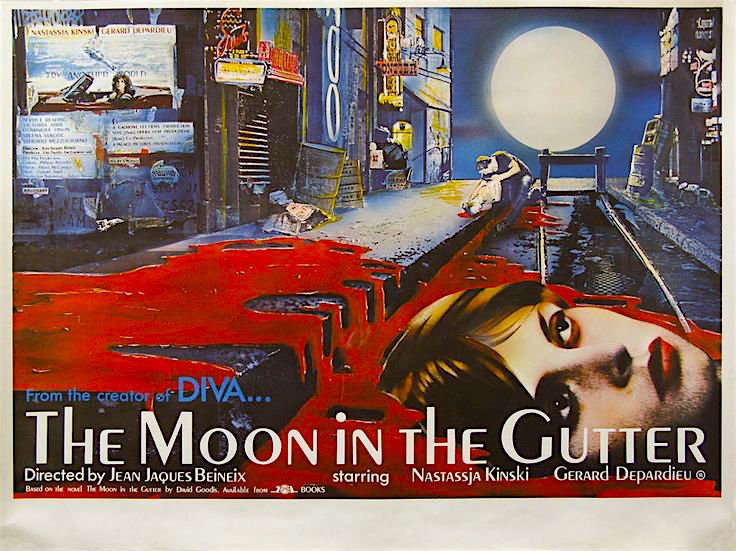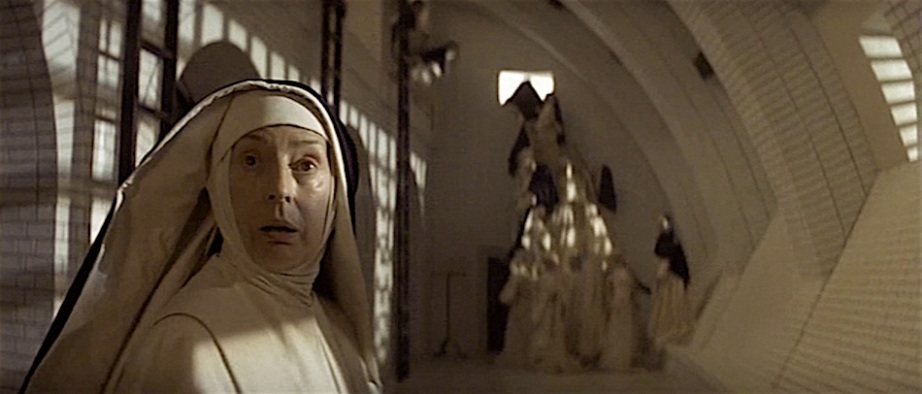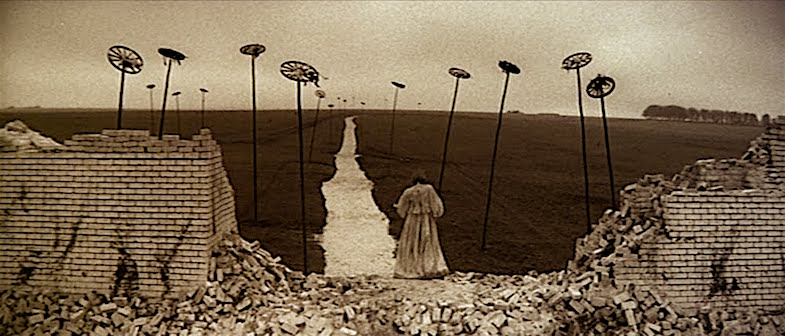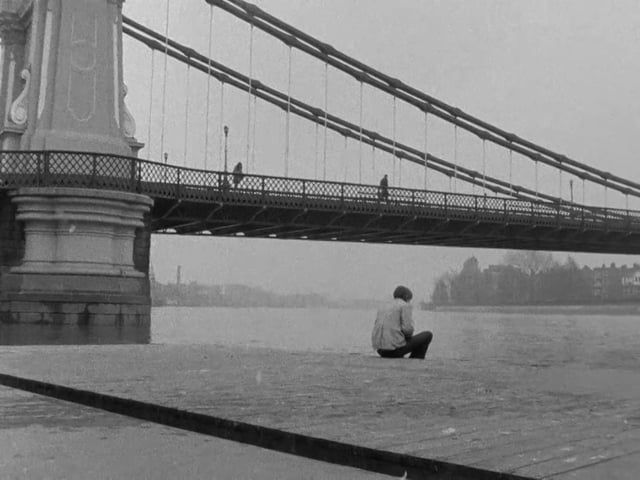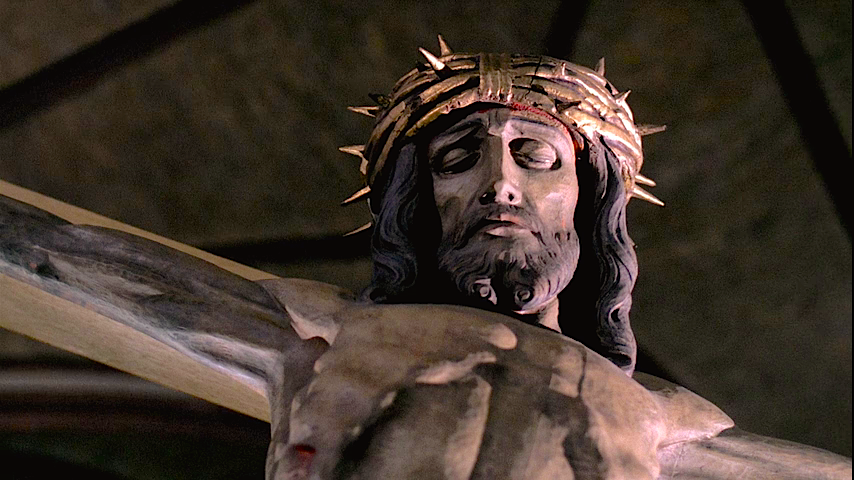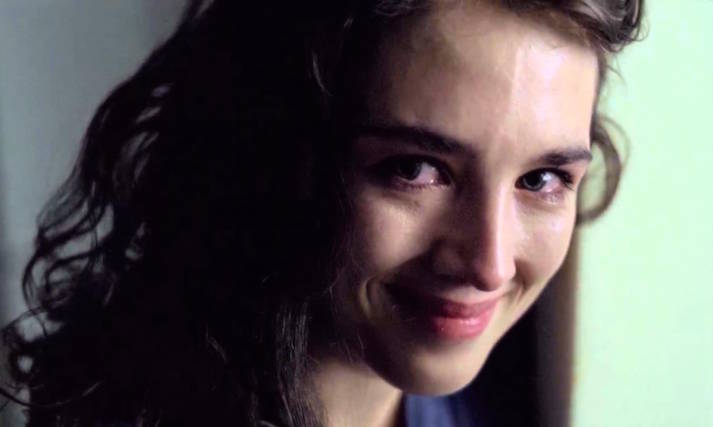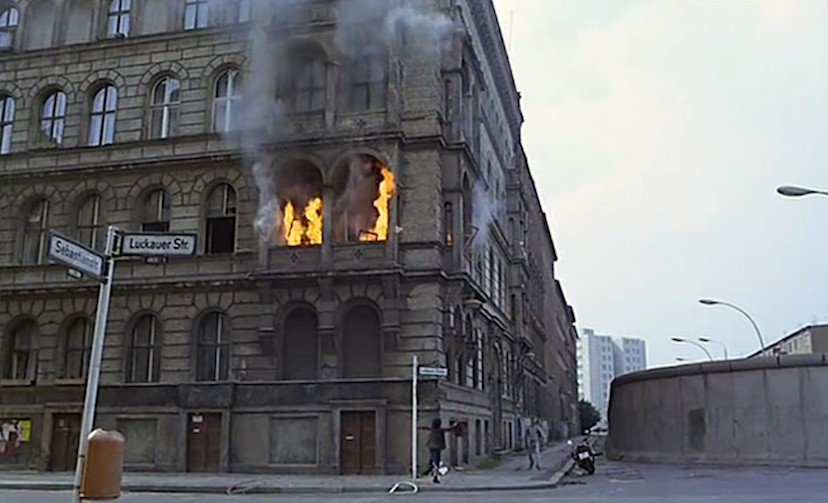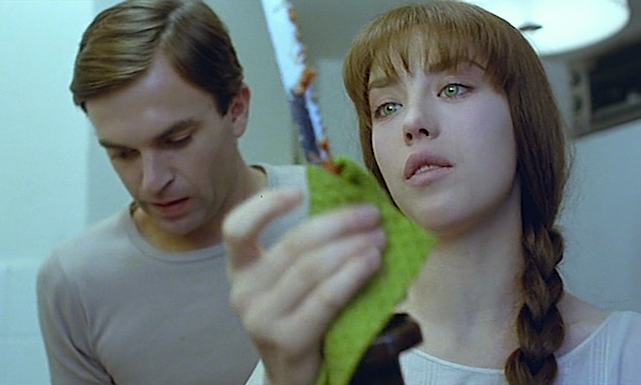As Dennis Hopper’s gritty and nihilistic film, Out of the Blue, we see and hear two things:
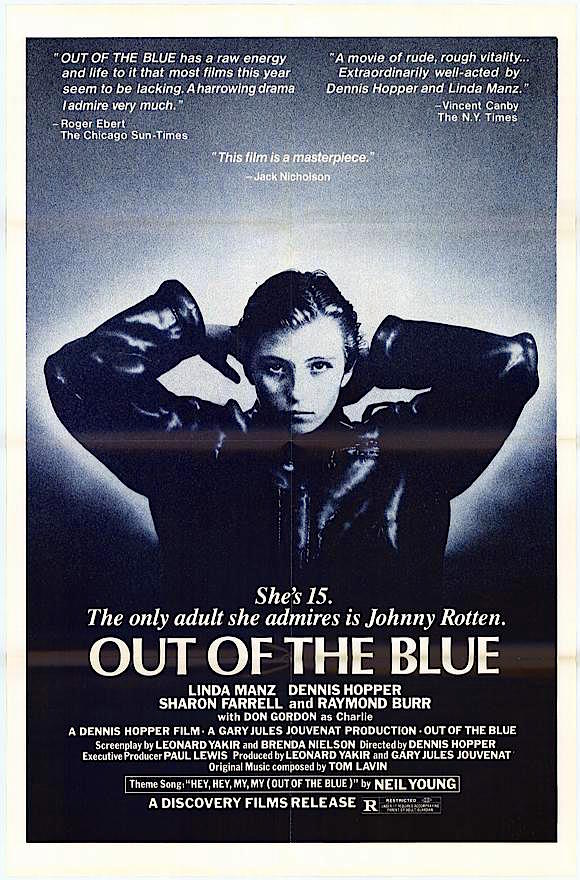
Out of the Blue
Dennis Hopper, 1980
the first is an 18-wheeler speeding along a stretch of road. In it sit a Halloween-costumed little girl and her beer-drinking dad. The drunk father teases his eleven year old clown of a daughter. She gleefully revels in his attention. Not too far ahead is a school bus full of elementary school age children. These are the trucker’s classmates. Their bus has stalled in the middle of an intersection.

A child and her addicted father on a Halloween joy ride to school quickly switches to a tragic crash into a school bus…
Out of the Blue
Dennis Hopper, 1980
Cinematography | Marc Champion
The little clown too lost in the bliss of her father’s attention and her father too drunk to allow for appropriate reflexes, the 18 wheeler crashes directly into the school bus. Suddenly this shocking action is ended as that same little girl some four years later bolts up in her bed. She has been dreaming. Linda Manz plays “Cebe” and we at once see the magic that this young actor was able to bring to the screen. She has no dialogue. She doesn’t need any. Her face shows it all. Confused, frightened and bemused. Cebe (clearly named after the Trucker mode of communication, the CB radio) appears to be uncertain if she has fully woken from the nightmare. But it only takes a few seconds for the audience to notice two visible scars on her face. This scene and whatever hope that what we have just witnessed by simply be a nightmare is killed with an instant cut to the cab of that 18 wheeler. Sitting in a ramble overgrowth of weeds, the cab is basically demolished. It is the dead of night, Cebe sits in the driver seat wearing her father’s Post-Hippie leather cap. She is talking into the CB radio transmitting a rant that we soon will realize fuels her ability to analyze and move forward in her life:
“Subvert normality. Punk is not sexual, it’s just aggression. Destroy. Kill All Hippies. I’m not talking at you, I’m talking to you. Anarchy. Disco sucks. I don’t wanna hear about you, I wanna hear from you. This is Gorgeous. Does anybody outthere read me? Disco sucks, kill all hippies. Pretty vacant, eh? Subvert normality. Signing off. This is Gorgeous. Signing off.”
The listening truck drivers do not understand. Cebe doesn’t care. She simply needs to be heard.

Linda Manz as Cebe
Out of the Blue
Dennis Hopper, 1980
Cinematography | Marc Champion
Originally intended to be a Canadian film about a child psychologist who saves and offers redemption for a fifteen year old girl who has murdered her own father. If what one is to believe what has been reported, stated and written, this entire film was intended to be a star vehicle for Raymond Burr. The producers had been lucky to cast American actor, Linda Manz, as the teenager in trouble. The film’s original director was in over his head and working with a script that seemed more aimed at some sort of “white-wash” of cultural tragedy more appropriate for ABC’s After School Special than cinemas. Dennis Hopper had taken the job to play the murdered father. After the original director walked-off, the iconic actor was asked to make his first directorial turn since his infamous The Last Movie failure.
Dennis Hopper immediately set out to re-write the perversely tidy teenage murderer saved script into something attached to humanity and reality. Raymond Burr was a tax credit for the film’s producers. Hopper manipulated Burr into thinking that he was still the lead actor. He apparently filmed a great deal more than the two brief scenes in which we see him in Hopper’s film. The Child Psychologist is reduced to a half-heartedly sincere bureaucrat. Hopper switched the perspective from a Canadian Social Worker to that of the tormented teenage girl. He also rejected the general premise of “Cebe.” She was no longer just a one-dimensional child victim turned murderer. Hopper’s Cebe was a damaged teenage girl trying to make sense out of her situation, her life and her own identity. Hopper, a former Hippie and addict, quickly decided to have Cebe obsessed with two cultural touchstones: Elvis and the PUNK Movement.

Only her father’s old leather cap and a safety pin for her check remains to complete her warrior armor…
Linda Manz
Out of the Blue
Dennis Hopper, 1980
Cinematography | Marc Champion
Suddenly, Linda Manz was given more to do than simply supply screen presence and predictable emotions cued by violins. She was given the lead role of an abused child hellbent on rebellion and pushed to the emotional edge of sanity.
Cebe seeks more than to subvert normalcy, she seeks to subvert life itself because it is the only way she can figure a way to motivate through the pain, grief, humiliation and confusion of her life. Born to two rebels, Linda Manz’s Cebe is essentially the manifestation of free love, hippie ideology, mind-expanding drug use and confusion. Her mother appears to be a kind, but painfully emotionally-stunted ex-Flower Child. Here, Mom is only physically grown up. She married her true love, a tough Hippie Biker type who quickly grasped onto the life of a heavy hitting trucker.

Despite it all, a child needs to love her parents.
Linda Manz & Dennis Hopper
Out of the Blue
Dennis Hopper, 1980
Cinematography | Marc Champion
Cebe’s mother has forever give her heart to her husband, but she gladly hands over her body for some stability and a fix. We slowly figure out that Sharon Farrell’s Kathy is a closet heroin addict. She loves her daughter the best she knows how. Kathy doesn’t view her daughter’s rebellious nature as odd or worrying. Within Kathy’s limited understanding, Cebe is her father’s daughter. A natural born rebel. While Kathy has already hooked up with Dad’s best friend and former local nemesis, she is still married to Dad.
Kathy can’t wait for Daddy to get out of prison so that they can be a Happy Family again.

Burning what little ideal she covets of her parents, a child on the verge…
Out of the Blue
Dennis Hopper, 1980
Cinematography | Marc Champion
This was never a happy family. Cebe seems to be the only one fully aware of this.
She, too, is excited about her father’s release from prison and return to home. However, Linda Manz’s skill as a naturalistic actor allows her to show us that she is not so certain things will be getting better. She hopes that they will, but Manz’s forever perplexing ability to convey mixtures of emotions that often run against the very grain of her character’s dialogue and actions, we know she really expects that things for her are about to get a whole lot more difficult.
Her bedroom offers a great deal about the complexity of our lead character. Innocent childhood toys and 1970’s era children’s art remain in tact, but are almost buried beneath the impact of shrines to Elvis. Cebe has crafted old Elvis album art and magazine photographs into collages better suited to religious iconography. A huge amplifier, drum kit and an electric guitar take the front and center of her room.
While the Elvis art seems old and fading, newer posters, pictures and magazine cut-outs weigh down the walls. These are all related to PUNK rock. The Subhumans, Sex Pistols, Teenage Head & Public Enemy are among the iconic bands name-checked on Cebe’s walls. Linda Manz’s Cebe was something altogether new to cinema.

OUT OF THE BLUE, Linda Manz, Sharon Farrell, 1980
This is the child of an addicted murderous father and an Up With People hippie gone to seed. Born into a life of instability, threat and fear — Cebe is constantly seeking new totems and sounds to bolster herself. She must reinforce her strength and appearance of knowledge and power to stay ahead of the game.
She clearly does not possess a clear understanding of either Elvis or PUNK rock. But she painfully understands the messages conveyed.
She may not understand the joke that Elvis had become by the time she was old enough to know his music. She also may not understand the corporate ownership of “Johnny Rotten” / “Sid Vicious” or the tragedy of their lives, but she gets the over-all jest of what they and their music stood/stand for.
She can’t articulate what “pretty vacant” actually means, but she somehow understands it applies to her life and the lack of hope it provides.
Rebellion is all she has.

A startling glimpse into the psyche of a 15 year old girl born of free love, addiction and rebellion. She hides it, but the numbing reality of her life is constantly revealed by the all-too-realistic nuance of Linda Manz’s performance.
Out of the Blue
Dennis Hopper, 1980
Cinematography | Marc Champion
Upon her father’s return things around Cebe seem to take on darker aspects.
Her mother’s drug use is now done in the living room. Even though Dad is home, Mom is all the more open about pursuing her sexual needs.
Dad has taken his drinking to a new level.
Classmates and some parents view her father’s return as an injustice to the children who were killed by the drunken crash four years earlier.
Worse yet, mother loses her worries in H while Dad and his pal take matters into their own hands and murder the father of one of the children killed in the tragic accident. The angry father feels the need for vengeance. Even a hint of his anger is enough to stir Dad to go into full attack mode.
Cebe runs away. She sleeps on the streets and ends up in a sexualized world of predators. Smart enough to run from this world, she still returns home.

Sleeping on the streets seems a safer alternative to home. This is no late 70’s After School Special. This is dire and real.
Linda Manz
Out of the Blue
Dennis Hopper, 1980
Cinematography | Marc Champion
When she gets back, she has hardly been missed.
The final straw arrives when a drunken argument between Mom, Dad and dad’s best friend, played by Don Gordon, lead to a non-sensical idea that Cebe has become too butch (or “a dyke“) to use Mom’s words. In drunken/stoned stupor it is decided that Don must have sex with Cebe to set her “straight.” Hearing it all from her room, Cebe begins to transform into a sort of asexual PUNK God.
Fighting off her father as if where a lion, her bedroom chair legs aimed at him like spears — the father retreats. After slapping the stoned out mom a bit, mom returns to Cebe’s side to help her into her nightgown.
So angry. So alone. So desperate. Cebe’s rebellion takes a very dark turn.
She opts to patricide and suicide as her ultimate “PUNK” revenge. Just as you would expect from Dennis Hopper, the nihilistic ending feels almost surreal. But it isn’t. This is a reality born of rage. No child psychologist can apply some words and therapy to take away the crime of her murders. If Cebe knows two things it is that she wants to kill her parents. It is hard not to relate to her conclusion. It is her suicide that is the tragedy.
Hopper’s film offers a grim view of a societal issue.

Embracing the ideology of PUNK rebellion and the reality of her life, Cebe teases her drunk, brutish and leering father’s sexual advances.
Linda Manz and Dennis Hopper
Out of the Blue
Dennis Hopper, 1980
Cinematography | Marc Champion
By the time the film was ready for release, several minutes involving the disturbing scene in which the daughter sexually taunts her father prior to brutally killing him had to be edited to secure an “R Rating.” Originally conceived as a Canadian film, the Canadian Film Board quickly demanded funds returned and denied Canadian approval. The film was not released to Japan until the 1990’s over concerns related to rebellion, patricide and suicide. In the US the film barely managed a limited release. While it was largely supported by film critics — even Jack Nicholson stepped out of the celebrity bubble to promote the film which he felt had something very important to say.
The film quickly became a source of infamy.

Bebe applies her make-up to bolster strength.
Linda Manz
Out of the Blue
Dennis Hopper, 1980
Cinematography | Marc Champion
Interestingly, it began to develop a misleading reputation as a PUNK Rock Movie. It is not.
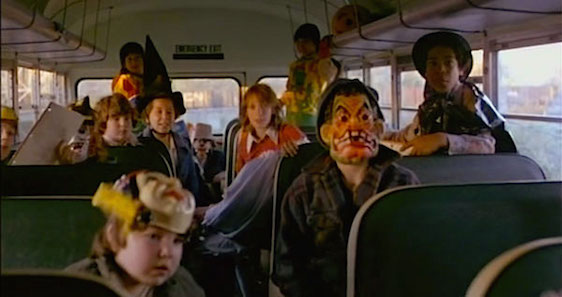
Costumed for fun a school bus full of children are trapped
Out of the Blue
Dennis Hopper, 1980
Cinematography | Marc Champion
When AnchorBay was able to release the theatrical cut on DVD in 1999, the sales started off high. Driven by the rumors surrounding the film as PUNK Statement. Those sales quickly dwindled. Out of the Blue is not a fun movie. It is grim, gritty, realistic and offers the audience no easy way out. While the film does suffer from budget restraints. The crash into the school bus is not as potent when the film returns to the incident the second time and “goofs” can be seen. But mostly, this angry film remains a valid glimpse into human darkness.

A disturbingly logical but incorrect application of Elvis and PUNK mythology into identity.
Linda Manz transforms…
Out of the Blue
Dennis Hopper, 1980
Cinematography | Marc Champion
Although I am unsure if he has ever publicly discussed this film, it clearly had impact on Harmony Korine. Any Knowledgeable film-buff will see this film’s influences on Korine’s work.
It also captures teenage rebellion with a cause.
Technically, AnchorBay no longer has this film in print, but copies can still be found on Amazon. Sadly, many other versions of this film are out there on DVD. Be warned: most are of very poor quality. Most look as if second-hand dubbed from old VHS tapes. And most of the non-AnchorBay prints are heavily censored. It remains to be seen if this film will ever find it’s way to restoration.
1969’s Coming Apart offers an equally realistic and dark journey to the heart of human self-destruction, but with a different sort of reason in mind. Milton Moses Ginsberg’s much discussed film is one of style, human pain and classic NYC Method Acting. Often compared to Jim McBride’s David Holzman’s Diary. In truth Ginsberg’s film has very little to do with McBride’s groundbreaking film beyond the use of “documentary” style and mirror metaphor. The idea of exploring identity and/or sexual identity is not really traceable to one work of art. What makes Ginsberg’s experimental 1969 film so important is that it captures more than just a time capsule moment within the 1960’s Counterculture Movement as it brings focus to the resulting identity problems that movement helped to acerbate. It also serves as a great example of the power to be found within filmmaking.

Setting up a hidden movie camera in a mirrored box designed to look like an object of art. Welcome to the world of “Joe Glassman”
Coming Apart
Milton Moses Ginsberg, 1969
Cinematography | Jack Yager
Having just survived a devastating end to a relationship which led him to securing an apartment in the same building as the woman who had rejected him, Milton Moses Ginsberg essentially found himself in an existential downward spiral. This experience drove him to create the script for Coming Apart. An almost shockingly detailed script, he also sought to utilize some of the most respected young actors trained directly under the mythic teachings of Lee Strasberg. Very few of the actors seen in this film were not members of the original Actor’s Studio. It’s three leading actors were among Strasberg’s most prized pupils. They were also known as his most fearless actors who fully embraced every philosophy of Strasberg’s ideology. Rip Torn, Viveca Lindfors and Sally Kirkland may not have been the most famous, but they commanded a great deal of respect within the realm of NYC Actors and Method Acting. The easiest way to sum up Strasberg’s Method Acting was to understand and pursue acting as truth. Truth without filter. Truth without censor. Truth pursued at all costs and concentration. Essentially, Method Acting seeks to pursue the truth of the human soul to it’s deepest and often darkest depths. This was and remained the essential elements of all three actors.

Checking his hidden camera’s perspective…
Rip Torn
Coming Apart
Milton Moses Ginsberg, 1969
Cinematography | Jack Yager
Milton Moses Ginsberg once stated that the Coming Apart script served as a “vehicle for actors to reach into their souls and I found two actors who could reach deeper and better than any others at that time.” He was referring to both Rip Torn and Sally Kirkland. But the entire film is filled with Method Actors. This is particularly interesting to note as most who have seen Coming Apart walk away from the experience thinking that they have seen improvisation and even partial biographical film. This is not at all true. Almost everything in the film is scripted. While Ginsberg was not afraid of improvisation, he expected that each actor honor his script. They did. Each was fully invested in the three week project.
It is interesting to note that every single film snag, break, audio interference, audio loss and distortion is clearly listed and often even drawn into the script. When we are unable to hear or see something it is because Joe can’t deal with hearing or seeing it himself. The only post-production decision to deviate from the script was Rip Torn’s long rant into the camera. It was originally to be an articulated four minute rant during which Torn’s Joe experiences an emotional break. Ginsberg felt at looking at Rip Torn’s face was far more insightful than his own words. So he added unplanned chops and drops of sound during this one scene.
The idea of the film stems from the writer/director’s own self-destructive act of almost stalking a former lover, the premise is quite simple. A burned-out and emotionally ravaged psychiatrist rents an apartment in the same building as that of a woman with whom he had what he feels was a meaningful affair. However, this does not stop the doctor from pursuing an experiment in which he hides a movie camera within a mirrored box. Intended to look like a piece of modern art, he places this hidden camera so that it captures the goings on in the living room from one perspective. Trained on a sofa, “Joe” has placed the sofa in front of a huge mirror. In this way, the camera picks up all activity from two perspectives.

“What’s this?”
“Kinetic art object.”
“What?”
“Modern sculptory.”
Coming Apart
Milton Moses Ginsberg, 1969
Cinematography | Jack Yager
While he has set up the apartment as a sort of trap which will require his former lover to interact with him, he is also intent on filming his interactions with women. What at first seems like an extended and sick “bachelor’s weekend” soon devolves into an examination of sexuality and identity at it’s core root. Almost immediately the audience is placed in the role of Voyeur. It is an uncomfortable place to be. There is very little erotic about the goings-on, but it is quite sexual. It is also intense, provocative and disturbing.
When Joe’s former love confronts him for having crossed a line by moving into her building, Joe’s idea backfires. Viveca Lindfors’ Monica is not interested in Joe. If anything she pities him. But is Joe even worth pitying?

“Did I do this to you, Joe?”
Viveca Lindfors & Rip Torn
Coming Apart
Milton Moses Ginsberg, 1969
Cinematography | Jack Yager
Joe’s first visitors are there strictly for sex. The first encounter comes the closest to being erotic. The second encounter with Elaine played by Lois Markle in one of the film’s few comical moments, presents Joe with a type of sexuality he has perhaps only studied or discussed with patients. When presented with a true sadist, Joe isn’t sure about what he should do. In both comical and realistic ways, Markle’s characters tries to turn Joe on by exposing the permanent scars caused by cigarettes. It would seem that Elaine enjoys being a human ashtray.
This does nothing for Joe. She quickly suggests putting on provocative clothing. She even quickly runs back to her home to return in full-on BSDM gear designed to entice. Joe seems more curious than turned on. As she shows off her spike heel shoes, Joe asks her if it is hard to walk in them? She advises that these shoes are not for walking. Just when it seems she is about to give up all hope of getting laid, Joe decides to feign interest. As he pursues her on the floor, we see her legs up in the hair and she returns to her cooing and moaning while yelling, “You’re raping me! You’re raping me!” We see Joe hesitate and Elaine reach up and pull him back to her. She then returns to pretending that Joe is raping her. This is the only “light” moment to be found in Coming Apart.

Are you sure you don’t want to put a cigarette out on me?
Rip Torn & Lois Markle
Coming Apart
Milton Moses Ginsberg, 1969
Cinematography | Jack Yager
The entire film runs like a document of what we would now call “found footage.” The scenes cut off. The film appears to run out or break. The audio goes off and on. The light has impact on the quality of the film and the way in which we can see. This approach has an interesting sort of effect for the viewer. Even when we don’t want to see everything, we often strain to keep up with what is going on in front of us. It is inappropriate. It is far too private. Welcome to being the target of the film. We are somewhat seduced into an act of voyeurism. The problem is that the eroticism of this film is short-lived. The erotic quickly becomes heart breakingly neurotic. Coming Apart is just that. We end up watching two people falling apart — or as their connection is grounded in the sexual, they are both cuming apart.
When we first see Sally Kirkland’s Joann, she sits on the sofa slacked and bored. Far too young for Joe and not the sort of woman we have been seeing. She is beautiful, but clearly not sitting there waiting for sex. However, Joann comes to animated life when we see Joe actually take an interest in her. In what is extremely naturalist and real dialogue we discover that Joe and Joann have run into each other just outside the building. She is also a former therapy patient who had quit therapy. She claims to have no interest in therapy, but Joe insists that it would be inappropriate for him to see her. He explains that he has cut back on therapy sessions and has taken this apartment to work on a paper for which he has been given a grant to write.

A drunken/stoned gathering quickly devolves into an uncomfortable challenge of group sex and sexual identity…
Sally Kirkland is disengaged as “Sarabelle” The Clown hits on Joe…
Coming Apart
Milton Moses Ginsberg, 1969
Cinematography | Jack Yager
This only seems to serve to excite Joann. Sally Kirkland’s character seems to be literally morph into a sexual being. She begins to shamelessly flirt with Joe. She mentions that she is involved with a man who likes to experiment. He likes to watch her get it on with other men. As she is clearly exciting Joe, she begins to tell him about an orgy she recently attended.
When he asks her more about orgies she responds, “It’s wilder than you can imagine.” And, it is here that we start to understand that Joann is every bit as broken as Joe. As she continues to try and excite him, she stumbles onto her own issues and woes. They slip out more clearly defined than a tale of her orgasm. “Why am I telling you all this for? You’re not my doctor!” Yet, she can’t help but keep speaking. Her rambling becomes less erotic than tragic and filled with self-loathing. Her energy drained, Sally Kirkland’s Joann is heart-broken and filled with a confused anger. Her body has started to fold in on itself but she continues to attempt some idea of body flirtation.
She tells him that her lover likes to call her “Whore.” It is apparent that Joann herself is confused why she has shared with Joe. It is a source of pain for her.
An awkward lapse of silence follows. Without any sort of reasoning, Joe offers “I’m lonely, too.”
This of course is as if he has given invitation. Joann has now placed herself across the room, hand close to Joe’s crotch — soon her head rests there as well. After allowing her to sublimate her entire body poised to give him oral pleasure, Joe cruelly dismisses her, “You’ve got to go to work and I’ve got to go home to my wife.”

“Let’s make the most of a bad thing, shall we?”
Rip Torn & Sally Kirkland
Coming Apart
Milton Moses Ginsberg, 1969
Cinematography | Jack Yager
But Joe may have met his match. Joann quickly turns the tables on him by pointing out that she’s relieved he has a wife. A slight pause as she glances toward his crotch, “I thought you were a fag.” This comment seems to have a far greater impact than we expect. Before long Joann is back an affair begins. Or at least, a sexual relationship begins. We see her consistently working hard to bring him sexual pleasure, but Joe seems to have lost the ability to achieve a hard-on. Drunk and nude, both Joann and Joe seem miserable. The camera unknown to Joann, Joe appear to start mugging at his camera — at us. It quickly becomes clear he is trying not to cry.
Later Joann returns, after a bit of an argument they end up attempting to have sex. She ends up masturbating against Joe’s leg. Sexuality between Joann and Joe seems to illicit impotence for Joe and rage for Joann. Just before his camera’s film runs out, he commands that Joann face away from him on all floors. The implication being that he can’t look at her to fuck her. Yet, Joann agrees. Four on the floor, Joanne waits. As Joe stands and removes his underwear, the film runs out.
A bit further into the film Joann returns with a whole group of people. All of whom seem to be in various degrees of intoxication. Group sex takes place, but it seems to present Joe and Joann with frustration. Joann seems angry. Joe seems afraid. When he mistakes a transgender female for a biological woman — this is 1969, but this person looks far more female than male. Later Joe is presented with a nude gay man who clearly wants to pleasure Joe. This is a returning theme in the film. Joe’s heterosexuality is consistently under scrutiny. It is never clear how much Joe’s developing sexual issue is related to the fact that perhaps he is sexually conflicted or merely depressed.

Sally Kirkland looks into the abyss…
Coming Apart
Milton Moses Ginsberg, 1969
Cinematography | Jack Yager
The downward spiral for Joe and Joann continues. Joe is clearly experiencing a nervous breakdown. Joann has been kicked out of her home — she claims this is because she has become Joe’s sex toy. Yet he refuses her a place to sleep. Telling her she stinks. We know that they have just had another unsuccessful attempt at sex. Beyond abusive, we have entered the realm of human cruelty.
At one point, Sally Kirkland’s Joann tells Joe: “You’re not as strong as I thought. You’re frightened. You’re weak-willed. There’s no mystery about you. None!”
She aims this as a threat, but she doesn’t give up. She continues to pursue Joe despite repeated failures, insults and even physical threat. It is illogical, but feels believable real.
It is crucial to note that there is nothing amateur or limited within Coming Apart. Each and every performance is so authentic in emotion, sexual need, desperation and rage that the viewer feels uncomfortable watching the interactions especially given that Ginsberg films it all from a secret camera perspective. Filled with mirror reflections that capture information from all perspectives with limitation of being stuck in the position of a perverse voyeur. A limited budget does not matter. Nothing is boring. The opposite. However, very little if any of it is “enjoyable.”

Half nude, loaded gun and on the attack: Sally Kirkland’s break results in unhinged destructive blood-lust
Coming Apart
Milton Moses Ginsberg, 1969
Cinematography | Jack Yager
Everything we see feels real. In fact, at the time the film was released many labeled it as pornographic. It carried an “X-Rating” and is still rated “NC-17” despite being tame in comparison to many films other than the entire movie just feels so real. And an even larger number of people refused to believe it was fictional. Even some of Rip Torn’s friends were convinced he had left his wife, Geraldine Page, for several weeks. Hired Ginsberg to take credit for shooting a film which was simply a drunken Torn having his way with women. This was something that was a source of both comedy and annoyance for both Rip and his wife. As for Sally Kirkland, she soon found herself being questioned about the idea of “Art vs. Pornography.”
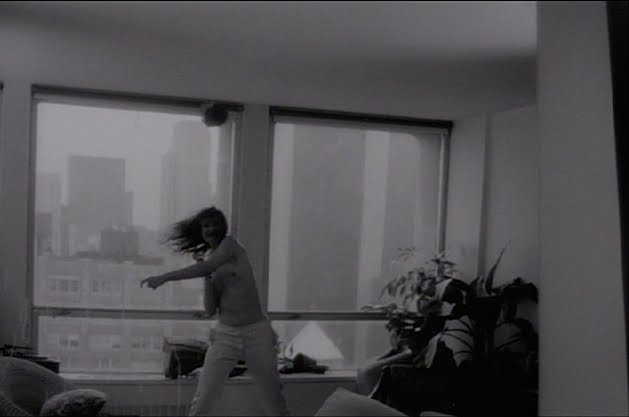
Raging and murderous, Sally Kirkland tosses a piece of art directly at us, or, uh, Joe’s hidden camera…
Coming Apart
Milton Moses Ginsberg, 1969
Cinematography | Jack Yager

Perception is attacked…
Coming Apart
Milton Moses Ginsberg, 1969
Cinematography | Jack Yager
The film was made at the darkest moment of the counterculture revolution. 1968 was indeed a tipping point for the United States.
“Erotica was very much a part of the Counter-Culture Revolution in the New York City art world!” Kirkland explained during a Q&A of the film in the late 1990’s.
Coming Apart for many of the actors was a natural extension of the revolution that they were so deeply vested. The was a revolution against war, oppression, inequality and perhaps most importantly — the Counter Culture was acting out against the regimented cultural and societal perceptions of what normalcy was supposed to be.
Like Dennis Hopper’s gritty little strange 1980 movie, 1969’s Coming Apart was also a subverting normality. It is of particular interest that this was all captured in what most would consider the final year of the 1960’s.
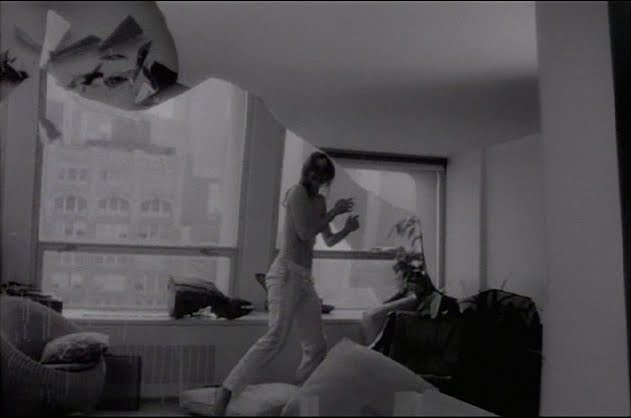
Reality shatters
Coming Apart
Milton Moses Ginsberg, 1969
Cinematography | Jack Yager

Despair, contempt, loneliness, heart break and rage destroy realistic perception once and for all…
Coming Apart
Milton Moses Ginsberg, 1969
Cinematography | Jack Yager
In the late 1990’s Sally Kirkland bluntly asserted to the audience for whom Coming Apart had just been screened, “People are still dealing with this revolution!”

Nothing left to see or say.
Coming Apart
Milton Moses Ginsberg, 1969
Cinematography | Jack Yager
While more than a few of her fellow artists would consider Sally Kirkland an eccentric, none would ever argue her intelligence. An esteemed, highly intelligent and articulate individual, Sally Kirkland really hit the nail on the heard. 46 years on and Ginsberg’s Coming Apart is still shocking and confusing viewers. In many ways, this film’s examination of sexuality, loneliness, desperation and human rage goes beyond authenticity. It pursues and touches the rawest of human nerves. For many, it might be easier to watch the extreme torture porn of Srdjan Spasojevic’s A Serbian Film.
The film continues to polarize audiences. However most cinephiles, critics and actors now see this film as a masterpiece.
Kino had issued a great DVD of the film in 2000. I get contradictory reports about whether or not Kino still has the rights to continue to print their DVD of the film. However, while it has sold well a second reprint was never required. Or, it was never done. It can still be found on Amazon. There are no plans in place to give this historic and highly personal film a restoration it deserves. It would be a good time to more forward as all three of the key players for this film are in their 70’s and early 80’s. One of the challenges seems to be regarding the use of Jefferson Airplane music.
One thing is for sure — neither of this films should be forgotten.
Actually, I don’t think either will. Both Out of the Blue and Coming Apart carry a certain cred that is undeniable. They also both retain a level of curiosity. Neither fit into mainstream cinematic ideas. Both push the envelope without sacrificing artistic merit. These two films have respective followings.

Naked despair, rage and sexuality come to limited cinemas in 1969.
Coming Apart
Milton Moses Ginsberg, 1969
Cinematography | Jack Yager
Matty Stanfield, 10.4.2015








